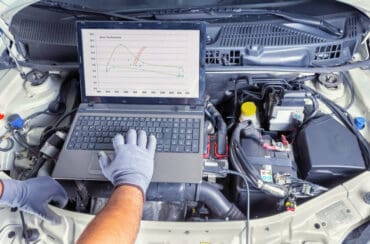
By integrating digital engineering methodologies with digital twins, EV manufacturers can streamline operations, enhance collaboration, and maintain a competitive edge in the increasingly complex and dynamic EV marketplace.
The dynamic nature and volatility of the electric vehicles market have forced auto manufacturers to adopt technologies like digital twins to more easily adapt their manufacturing processes and operations to meet changing customer preferences, regulations, and economic conditions. But increasingly, many are turning to even more sophisticated approaches by employing digital engineering methodologies in conjunction with their digital twins.
One of the key benefits of this integration is increased collaboration opportunities across various digital engineering groups within an organization. As we’ve noted in previous articles (here and here), such collaboration is needed due to the complexity of EVs and the need for a cooperative environment to bring the various EV elements together into a tightly integrated vehicle.
Benefits of Digital Twins in EV Manufacturing
Digital twins are being widely adopted by manufacturers of electric vehicles (EVs) to enhance design, production, and maintenance processes. Some of the main uses of digital twins include:
Design Optimization and Simulation: EV manufacturers use digital twins to create virtual replicas of their vehicles. This allows engineers to simulate different design iterations, evaluate performance under various conditions, and optimize components such as battery systems, aerodynamics, and drivetrain configurations. This reduces the need for physical prototypes, speeds up development, and cuts costs.
Battery Management and Testing: Digital twins are applied to model and monitor EV batteries in real time. Manufacturers can simulate how different materials, cell configurations, and charging cycles affect battery life, performance, and safety. By gathering data from the real-world usage of batteries; digital twins help to predict failures and improve battery management systems.
Production Efficiency: In manufacturing, digital twins mirror factory operations, enabling real-time monitoring and optimization of assembly lines. Manufacturers can simulate production workflows, pinpoint bottlenecks, and optimize resource allocation. This leads to increased efficiency, better quality control, and reduced downtime.
Predictive Maintenance: EV manufacturers use digital twins to continuously monitor vehicle performance by collecting data from sensors on actual cars. By analyzing this data, they can predict when parts will need maintenance or replacement, improving reliability and minimizing unexpected breakdowns. This is especially useful for fleet management of EVs.
End-to-End Lifecycle Management: Digital twins provide a comprehensive view of an EV throughout its entire lifecycle—from design and production to usage and eventual disposal. Manufacturers use this to track components, improve vehicle sustainability, and ensure compliance with environmental regulations.
The bottom line: The use of digital twins in electric vehicle manufacturing leads to more efficient development cycles, better vehicle performance, and longer product lifespans while also advancing the sustainability and adaptability of the vehicles.
Melding Digital Engineering into Digital Twins
Incorporating digital engineering methodologies throughout the digital twin lifecycle in manufacturing offers many benefits. The increased interest in bringing these technologies together is a growing trend across not just EV manufacturing but also manufacturing in general.
Earlier this month, the Digital Twin Consortium noted the importance of this trend with an announcement aimed at “expansion of its scope to include the development and execution of advanced digital engineering methodologies throughout the digital twin lifecycle.”
In the release about this expansion, Dan Isaacs, CTO and GM of the organization, said: “This represents a natural evolution of our mission. By embracing a wider range of digital engineering practices, augmented where most beneficial by the infusion of AI including multi-Agent GenAI, we are well positioned to enhance the digital engineering ecosystem further and address the complex challenges facing the industry today.”
Melding the two technologies is expected to bring benefits in several broad areas. They include:
Improved Design and Optimization: Digital engineering allows manufacturers to create highly accurate virtual representations of physical assets. By integrating advanced modeling, simulation, and analysis tools, manufacturers can optimize designs before physical EV production begins. This reduces prototyping costs and accelerates the design phase, ensuring the product meets performance standards from the start.
Enhanced Collaboration and Integration: Digital engineering promotes seamless collaboration among various teams, such as design, production, and maintenance, through shared digital models. It also integrates data from multiple sources—such as IoT sensors, production lines, and enterprise systems—enabling a holistic view of the product or system, which fosters better decision-making across the product lifecycle.
Real-Time Monitoring and Predictive Maintenance: With digital engineering methodologies, digital twins can be continuously updated with real-time data from the physical system. This enables manufacturers to monitor equipment performance, detect anomalies early, and predict potential failures, minimizing downtime and improving operational efficiency.
Faster Innovation and Adaptability: Digital engineering enables rapid iteration and testing of new designs and manufacturing processes in the virtual environment. This accelerates innovation by allowing companies to quickly adapt to new technologies, processes, and market demands without the need for significant physical retooling.
Cost Efficiency and Risk Reduction: Virtual testing and simulation through digital twins allow EV manufacturers to identify and mitigate risks before they occur in the real world. By identifying issues early in the design and production phases, companies can reduce costs associated with rework, material waste, and unexpected downtime.
Lifecycle Management and Sustainability: Digital twins, supported by digital engineering, enable manufacturers to manage the entire lifecycle of their EV products, from design and production to maintenance and end-of-life. This comprehensive view helps optimize resource use, reduce waste, and improve sustainability efforts by ensuring that assets are used more efficiently.
Customization and Scalability: Digital engineering methodologies allow EV manufacturers to easily customize products and processes for specific customer needs by adjusting the virtual models. This flexibility also supports scalability, enabling companies to quickly modify production lines or products in response to market shifts.
The end result: By integrating digital engineering methodologies with digital twins, EV manufacturers can streamline operations, enhance collaboration, and maintain a competitive edge in the increasingly complex and dynamic EV marketplace.







